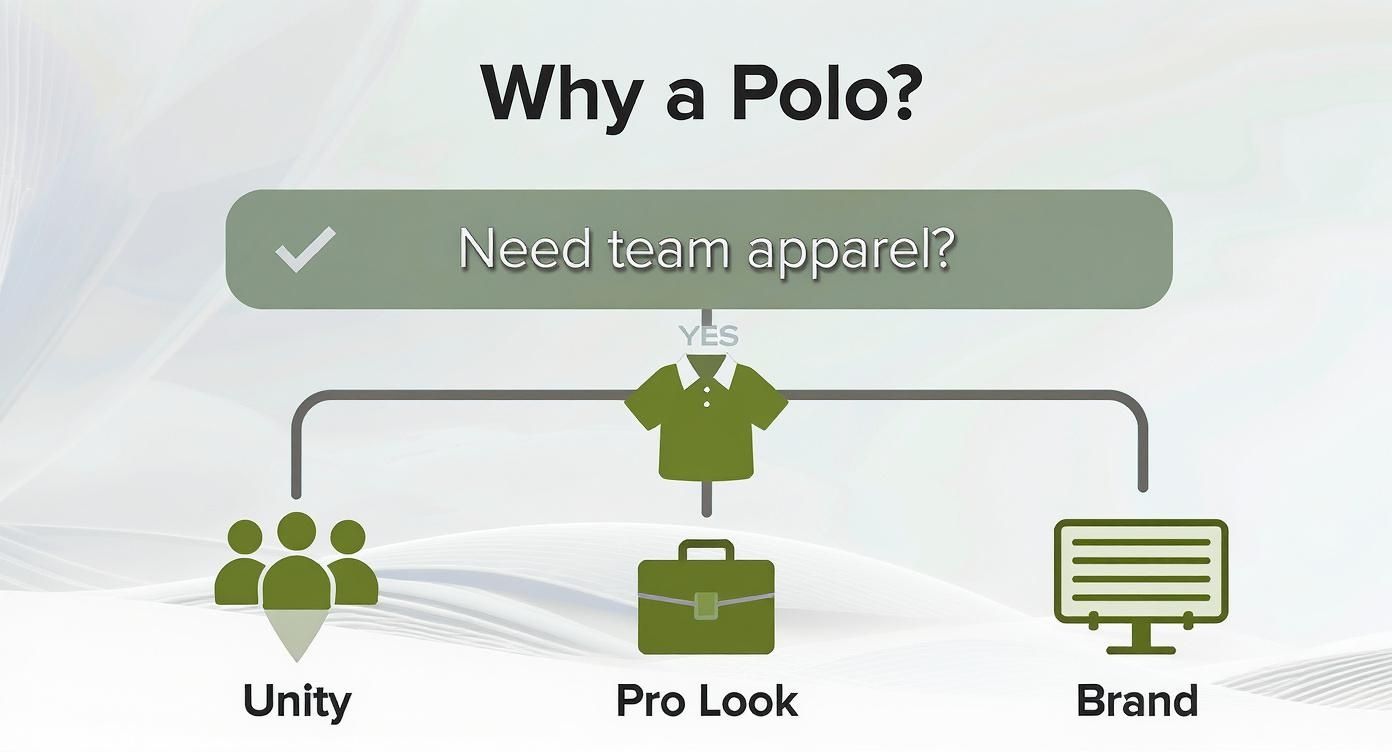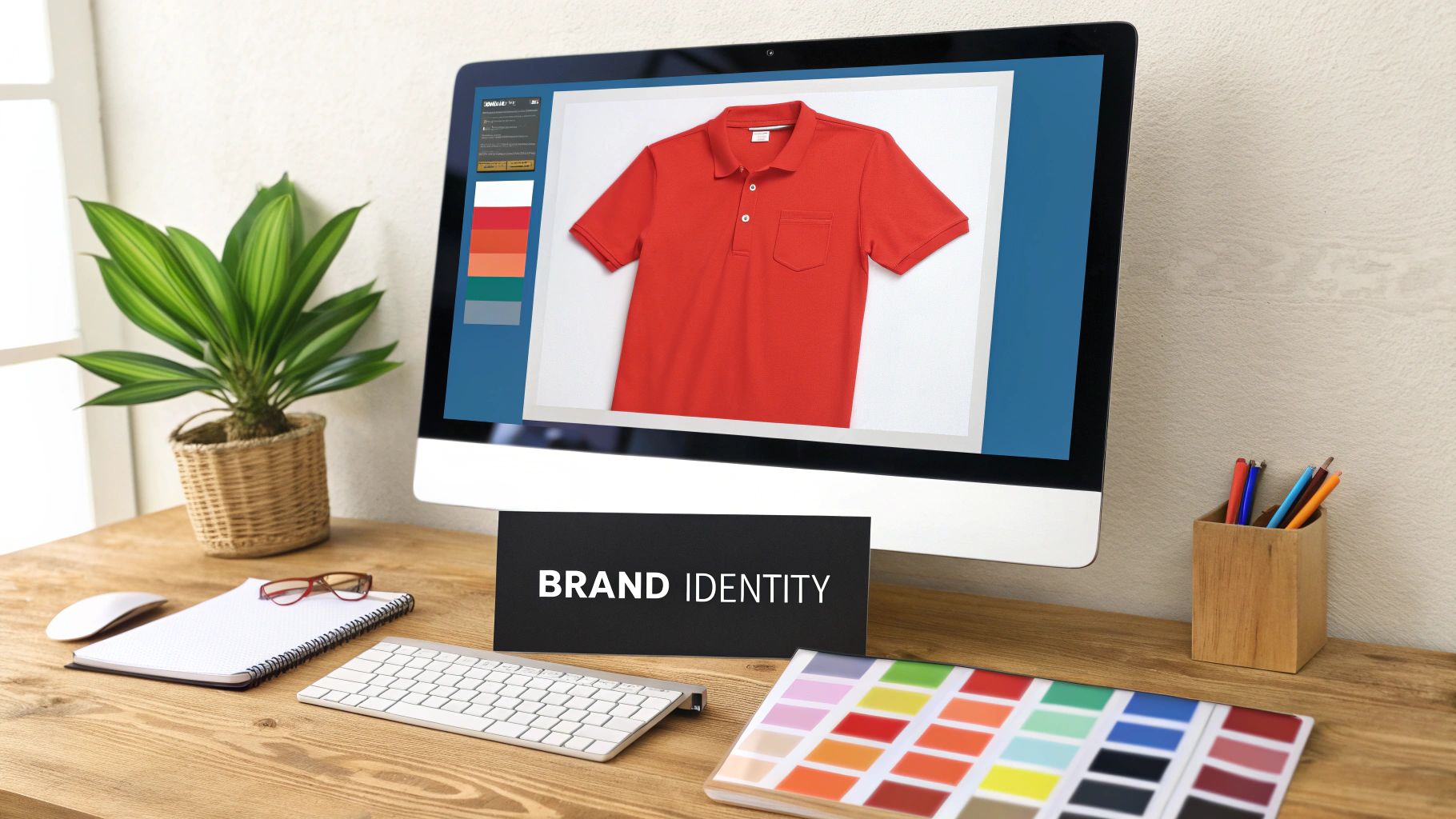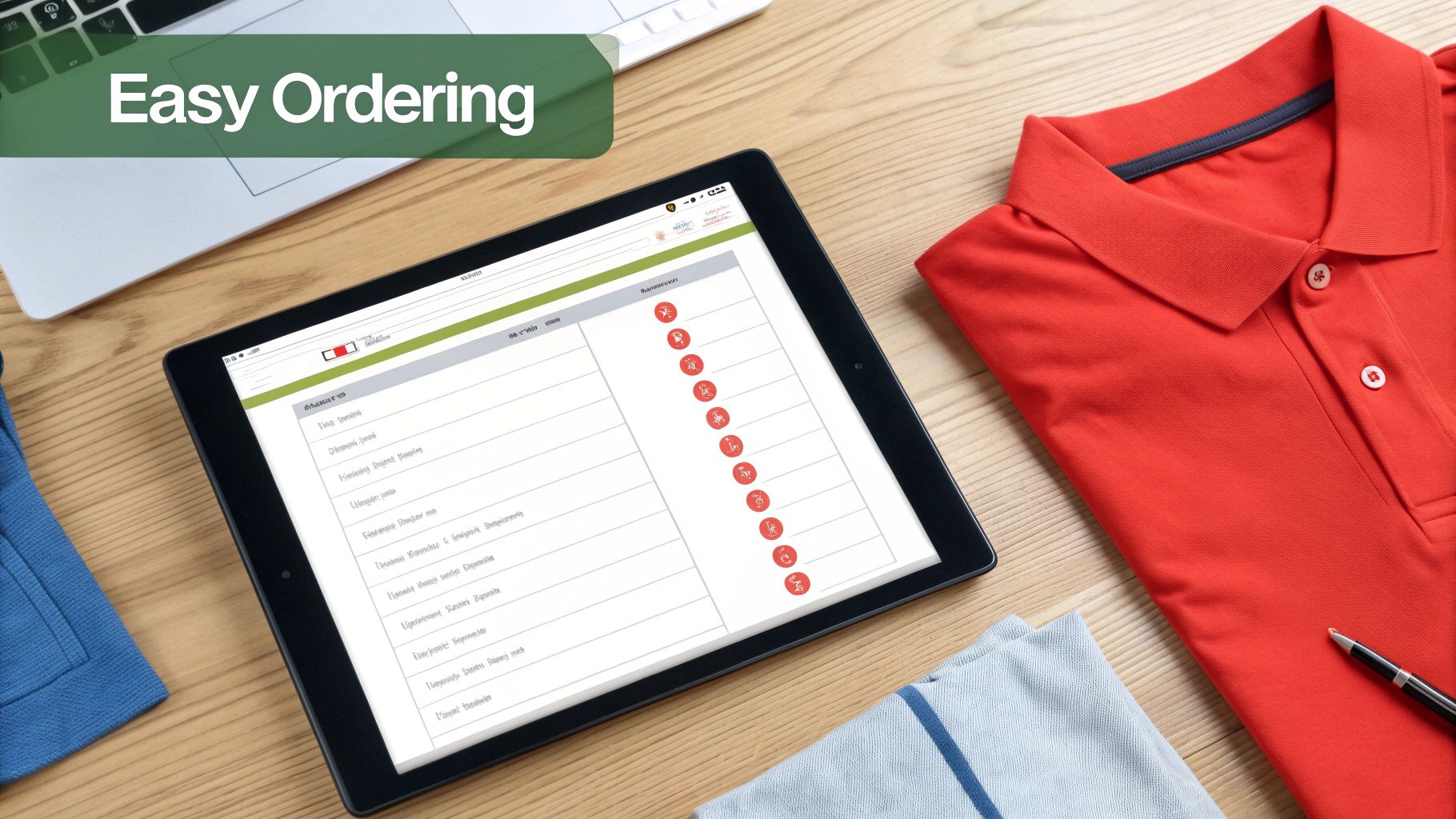More than just a uniform, a branded polo shirt is one of the most powerful, yet understated, marketing tools an Australian business can have. It perfectly walks the line between casual comfort and professional polish, effectively turning every single employee into a walking ambassador for your brand.
Why Branded Polos Are Such a Smart Business Move
Don't just think of a branded polo as another piece of clothing; see it for what it is—a strategic asset. For Aussie businesses, this one garment solves a few different problems all at once. It presents a unified, professional image to clients, builds a real sense of team spirit inside the company, and gives you constant brand exposure wherever your team goes.
Think about it. Every time an employee wears their polo to a client meeting, works a stand at an industry expo, or even just grabs a coffee, your logo is right there. This kind of low-key, continuous exposure is gold for building brand recognition. People trust what they're familiar with, and consistently seeing your brand in a professional setting cements your company's presence in their minds.
Building a Cohesive Brand Identity
A sharp, consistent uniform is a non-negotiable part of a strong corporate identity. When your people look like a team, they tend to feel and act more like one, and that unity has a direct impact on how customers see your business.
- Professionalism: A consistent look immediately tells people your organisation is established, organised, and cares about the details.
- Team Spirit: Wearing the same gear fosters a sense of belonging and puts everyone on the same level, which can do wonders for morale and collaboration.
- Customer Identification: Branded polos make your staff instantly recognisable at trade shows, on the shop floor, or during a service call, which makes for a much smoother customer experience.
When you invest in high-quality branded polo shirts, you're doing more than just dressing your staff. You are actively shaping how the public sees your brand and how your team feels about their workplace. It's a tangible way to show your company's commitment to quality.
To really get why this works so well, understanding fashion merchandising can offer some great insights into market trends and retail psychology. The same principles that make major fashion labels successful can be scaled down and applied to your corporate apparel strategy.
Think of this guide as your roadmap. We’ll walk you through every decision—from choosing the right fabric to finalising the design—to make sure you get a great return on your investment. For a bigger picture, exploring the wider world of branded merchandise for business can open your eyes to even more ways to get your brand's message out there.
Choosing the Right Fabric for Your Polos
The comfort, performance, and overall impression of your branded polos all come down to one crucial decision: the fabric. Think of it like picking the right tyres for a car; what works for a city runabout won’t suit a rugged off-roader. Similarly, the best fabric for an office-based team is completely different from what’s needed for staff working outdoors or at a high-energy event.
The material dictates everything from how the shirt breathes on a hot Aussie day to how well it holds its colour after countless washes. A poor choice can lead to uncomfortable staff and a uniform that looks tired and worn out, which completely undermines your professional image.
Let's walk through the most popular fabric choices for Australian businesses, so you can match the material to what your team actually does day-to-day.
The Classic Choice: 100% Cotton
For pure comfort and a classic, professional look, 100% cotton has always been the gold standard. It’s a natural fibre known for its softness and fantastic breathability, making it an ideal choice for corporate office environments or client-facing roles where all-day comfort is a must.
Cotton polos just feel great against the skin and offer a premium look that pairs beautifully with high-quality embroidery. They’re the go-to for businesses wanting to project an image of established quality and sophistication.
Just keep in mind that pure cotton can be prone to wrinkling and takes a bit longer to dry. It's also less resistant to stains than its synthetic cousins, making it better for less physically demanding jobs. You'll often see cotton in a pique knit—a textured, geometric weave that’s not only more breathable but also brilliant at hiding minor perspiration.
The Durable Workhorse: Poly/Cotton Blends
For most businesses, finding that perfect sweet spot between comfort, durability, and easy care leads straight to a poly/cotton blend. These fabrics usually mix about 65% polyester with 35% cotton, giving you the best of both worlds.
You get the softness of cotton combined with the strength, wrinkle resistance, and colourfastness of polyester. This blend creates a fantastic everyday uniform that can handle the rigours of daily wear while still looking sharp.
- Longevity: Blends are tough, resisting shrinking and stretching out of shape.
- Easy Maintenance: They need minimal ironing and dry much faster than pure cotton.
- Cost-Effective: Poly/cotton blends often give you great bang for your buck, offering serious durability at a reasonable price.
This infographic breaks down why a polo shirt is such a smart move for team apparel.

As you can see, the decision to use branded polos directly supports key business goals like team cohesion and brand visibility.
The Active Performer: 100% Polyester
When performance is what matters most, 100% polyester is the undisputed champion. This synthetic material is engineered for teams on the move, making it the perfect choice for outdoor workers, sports teams, event staff, or anyone in a physically active role.
Polyester is famous for its moisture-wicking properties. Instead of absorbing sweat like cotton does, polyester pulls moisture away from the skin to the fabric's surface where it can evaporate quickly. This keeps the wearer cool, dry, and comfortable, even in the middle of an Australian summer.
Modern performance polyesters often come loaded with extra features like anti-odour treatments, snag resistance, and UPF sun protection, making them a high-tech option for active work environments.
The market for polo shirts is booming, both here in Australia and globally, driven by a preference for versatile, comfortable clothing that suits modern work life. This demand is being met not just by classic cottons but by these innovative performance fabrics. You can discover more insights into the growing polo shirt market and learn about the trends shaping the industry.
To make the decision a little easier, here's a quick comparison of the main fabric types.
Polo Shirt Fabric Comparison
| Fabric Type | Best For | Key Benefits | Considerations |
|---|---|---|---|
| 100% Cotton | Corporate offices, client-facing roles, premium branding | Exceptionally soft, breathable, classic professional look | Prone to wrinkling, slower to dry, can stain more easily |
| Poly/Cotton Blend | General workwear, trades, retail, hospitality | Durable, wrinkle-resistant, holds colour well, easy care | Less breathable than pure cotton |
| 100% Polyester | Outdoor work, sports teams, events, active roles | Moisture-wicking, quick-drying, fade-resistant, holds shape | Can sometimes feel less "natural" than cotton |
Ultimately, choosing the right fabric comes down to understanding your team's daily environment and what you want your brand to represent.
Embroidery vs. Printing: Your Logo Decoration Guide
Choosing the perfect fabric for your branded polos is a massive step, but how you get your logo onto the shirt is just as crucial. It's a decision that will shape the final look, feel, and lifespan of your apparel. You've really got two main paths: embroidery and printing. Each one brings something different to the table.
Here’s a simple way to think about it: embroidery is like sculpting, while printing is like painting. Embroidery uses thread to stitch your logo directly into the fabric, giving it a classy, three-dimensional texture. Printing, on the other hand, applies ink or a transfer onto the surface, which is perfect for capturing vibrant colours and complex details.
Getting a handle on what makes each method special is the key to making sure your polos match your brand’s image and budget.
The Premium Feel of Embroidery
When you think of a classic, professional polo shirt, you’re probably picturing an embroidered logo. It’s a time-honoured technique where a digital version of your logo guides needles to stitch the design right into the garment. The result is a high-end, textured finish that instantly adds a sense of quality.
This method is built to last. An embroidered logo literally becomes part of the shirt, so you don't have to worry about it cracking, fading, or peeling off, no matter how many times it goes through the wash. That durability makes it a smart investment for staff uniforms that need to look sharp day in and day out.
For businesses wanting to project an image of quality, stability, and professionalism, embroidery is often the default choice. The raised, tactile nature of the stitching gives a sense of substance and permanence that printing can't replicate.
Embroidery also works brilliantly on the textured pique knit fabrics most polos are made from. The weave of the material gives the stitches a solid base to hold onto, which means the final result is always clean and impressive. If you want to dive deeper, you can learn more in our detailed guide on what is embroidery.
The Vibrant Versatility of Printing
While embroidery has that classic appeal, modern printing methods give you incredible flexibility, especially when you’re working with colourful or highly detailed designs. The two most common options for polos are screen printing and digital transfers.
Screen printing is a process where ink is pushed through a custom mesh screen (a stencil, basically) onto the fabric. You need a separate screen for each colour in your logo, which makes this method incredibly cost-effective for big orders with fairly simple designs. The colours come out bold and punchy, creating a smooth finish that feels great.
Digital transfers (you might also hear them called heat transfers) work a bit differently. We print your design onto special transfer paper first, then use heat and pressure to apply it to the shirt. This method is a real problem-solver for:
- Complex logos: It can handle photographic details, subtle colour gradients, and a full rainbow of colours with pinpoint accuracy.
- Smaller orders: The setup is much simpler than screen printing, so it’s a great option for smaller batches.
- Lightweight fabrics: It sits perfectly on performance polyester polos where heavy embroidery might cause the fabric to pucker.
Printing is your go-to when your logo is visually complex or when you need a large run of promotional shirts for an event where budget and eye-catching visuals are the main priorities.
Making the Right Choice for Your Brand
So, how do you decide? Your choice between embroidery and printing really comes down to a few key things: your logo's design, your budget, the number of shirts you need, and the overall look you're trying to achieve.
| Factor | Best for Embroidery | Best for Printing |
|---|---|---|
| Logo Complexity | Simple logos with solid colours and bold text. | Complex, multi-coloured logos with gradients or fine details. |
| Durability | Extremely high; stitches last the lifetime of the garment. | High, but can eventually show wear (cracking or fading) over time. |
| Professional Feel | Creates a premium, textured, and high-end impression. | Produces a modern, sleek, and vibrant look. |
| Order Size | Cost-effective for small to medium orders. | Most cost-effective for large orders (screen printing). |
| Fabric Type | Ideal for heavier fabrics like cotton pique and poly/cotton blends. | Excellent for smooth surfaces like polyester or jersey knits. |
At the end of the day, there’s no single "best" method—just the one that’s best for you. By thinking through these points, you can pick a decoration technique that turns your branded polos from a simple uniform into a powerful branding tool.
Designing a Polo That Embodies Your Brand

A great branded polo is so much more than just a shirt with a logo slapped on it. It’s a piece of wearable branding, a walking conversation starter that tells your company’s story. When you get the design right, it feels professional and intentional, turning every team member into a proud brand ambassador.
The real goal is to create a polo people actually want to wear, not just one they have to.
This means getting strategic about every detail, from where you place the logo to the colours you pick. These small choices all work together to strengthen your brand identity. A thoughtfully designed polo elevates a simple uniform into a powerful marketing tool, building recognition and trust with every single interaction.
Strategic Logo Placement for Maximum Impact
Think of the polo shirt as a canvas and your logo as the masterpiece. Where you place it dramatically changes how people see your brand. While there are a few standard spots, each one offers a unique advantage.
The classic, go-to position is the left chest. It’s right over the heart, giving it a subtle yet official look that just feels right for corporate wear. This placement is clean, professional, and ensures your brand is front-and-centre during handshakes and conversations.
But that’s not your only option. Other great spots include:
- Right Chest: A solid alternative to the left, or you can use this space for secondary details like an employee’s name or their department.
- Sleeve (Left or Right): This gives off a more modern, sporty vibe. A logo on the sleeve is surprisingly visible from the side and adds a unique touch of branding flair.
- Back Yoke: Placing a logo just below the collar on the back makes a great impression as someone walks away. It’s the perfect spot for a website URL or a larger version of your brand mark, especially for event staff.
The key is to pick a location that enhances the shirt's overall aesthetic, not overwhelms it. A well-placed logo should feel like it belongs there, not like a last-minute addition.
Choosing Colours That Align with Your Brand
Colour is one of the most powerful tools you have in branding. The colours of the shirt and your decoration (whether it’s embroidery thread or ink) need to work together perfectly to represent your brand. You’re aiming for a combination that looks sharp, professional, and is instantly recognisable as yours.
Start with your core brand palette. If your logo is blue and white, a blue polo with white embroidery is a no-brainer. You could also flip it with a white polo and blue decoration. For something a bit more sophisticated, try a tone-on-tone approach—think navy blue embroidery on a light blue shirt. It’s an understated look that feels very premium.
Just be sure to avoid common mistakes, like picking colours that clash or using a thread colour that makes your company name impossible to read. Always, always get a digital mock-up to see how everything looks together before you give the green light. For some creative ideas, it's worth exploring some shirt design inspiration to see what’s possible.
Getting these details right is what separates standard uniforms from truly professional corporate wear that reflects your high standards.
How to Order Your Custom Polos Without the Hassle

Turning an idea for the perfect branded polo into a real, tangible product can seem like a huge job. But it doesn't have to be. By breaking it down into a few simple stages, you can make the entire experience—from getting a quote to unboxing the final delivery—completely stress-free.
Think of it as a simple checklist. A bit of planning upfront helps you sidestep the common mistakes, like ordering the wrong sizes or sending over a low-quality logo file. Getting these things right from the start saves a lot of time, money, and headaches down the track.
Let's walk through a straightforward process that will give you the confidence to order your custom polos like a pro.
Laying the Groundwork for a Successful Order
A little bit of prep work before you even reach out for a quote can make all the difference. The first thing you need to do is get crystal clear on what you need these polos for. Are they for your team's everyday uniform? A one-off trade show? A high-end gift for clients? The 'why' behind the order will shape every other decision, from the quality and fabric to your budget.
Next, it's time to crunch the numbers. Figure out exactly how many shirts you need and what your budget is. Knowing this from the get-go allows a supplier to point you towards the best options right away, instead of you having to wade through endless catalogues.
Finally, get your branding assets in order. Having your logo ready in the right format is absolutely essential for a sharp, professional finish.
- Vector File Format: You must provide your logo as a vector file. These typically end in .AI (Adobe Illustrator), .EPS, or .SVG. Unlike a standard image file like a JPG, a vector can be scaled up or down to any size without becoming blurry or pixelated.
Choosing Your Supplier and Finalising the Details
Okay, you've got your goals, budget, and artwork sorted. Now it’s time to find a great supplier and lock in the final details. Look for a reputable Australian company with solid reviews and a transparent process. A great partner acts as a guide, not just an order-taker.
Once you’ve found a supplier you trust, you'll work with them to finalise the nitty-gritty of your branded polo shirts. This is where you'll choose the specific polo style, fabric, and colours that best represent your brand. They'll also need a breakdown of all the sizes you require.
A word of advice on sizing: never guess. Always ask for a detailed size chart for the exact polo you're ordering. The best-case scenario is getting a physical sizing kit so your team can actually try them on to guarantee a perfect fit for everyone.
The last, most critical step is approving the proof. Your supplier will send you a digital mock-up showing exactly how your logo will look on the shirt. Scrutinise it. Double-check the logo’s size, its placement, and the colours. This is your final chance to request any tweaks before the production line starts rolling.
By following these steps, you're setting your project up for a smooth run. For a full breakdown of the journey, you can learn more about how to order promotional products and what to expect.
Maximising the Return on Your Apparel Investment
It's easy to see branded polo shirts as just another line item in the budget. That’s a mistake. Think of them as a strategic asset—a real-world investment in how people see and remember your brand. When you get it right, the return isn’t just about how long the shirt lasts; it’s measured in brand visibility, a more unified team, and a sharper professional image.
Every single time a team member puts on their polo, they become a walking billboard for your business. This kind of consistent, subtle exposure is incredibly powerful. It builds brand recognition at trade shows, reinforces your identity during client meetings, and shows everyone a united front that speaks volumes about your company’s professionalism.
Extending the Lifespan of Your Investment
To get the best bang for your buck, you need your polos to last. High-quality shirts are made to be durable, but a little care goes a long way in keeping them looking smart and professional.
Passing on a few simple care instructions to your team can make a huge difference. Encourage them to:
- Wash inside out: This is the single best way to protect embroidery or a print from getting scuffed up in the wash.
- Use a cold wash cycle: It’s much gentler on the fabric and helps stop colours from fading.
- Avoid harsh detergents: Bleach and other strong chemicals will wreck both the fabric and your logo.
- Air dry when you can: Tumble dryers are rough on clothes and can cause them to shrink and wear out faster.
By sharing these simple tips, you help your team keep their uniforms looking sharp, ensuring your investment continues to pay off.
Beyond the Daily Uniform
Don't limit your branded polos to just the 9-to-5 grind. Thinking a bit more creatively about how you use them can seriously boost their marketing power and overall value. A top-quality polo makes an excellent corporate gift for a key client or can be used as premium merchandise at an event, leaving a lasting positive impression.
This mindset shifts the polo from a simple uniform to a flexible branding tool. It's worth noting that the local menswear manufacturing scene in Australia influences what’s available and how much it costs. While imports are a big factor, there’s a growing appetite for functional, smart-casual gear, which is great news for a versatile item like the polo shirt. You can read more about Australian menswear manufacturing on IBISWorld.com.
Encouraging Team Adoption and Pride
For your investment to truly deliver, your employees need to want to wear their branded polos. The best way to achieve this? Get them involved in the selection process. When people have a say in the style, fit, or even the colour, they feel a sense of ownership and are far more likely to wear the uniform with genuine pride.
Your team members are the ultimate judges of comfort and practicality. A polo that looks great but feels awful will quickly end up at the back of the wardrobe, completely defeating its purpose as a branding tool.
Focus on choosing high-quality, comfortable fabrics that are actually suited to their day-to-day work. Of course, getting the right gear at the right price is just as important. That's why we offer a best price guarantee to help you stretch your budget without ever compromising on quality.
At the end of the day, a happy team in sharp, comfortable uniforms is your most powerful marketing asset. They carry your brand's message of professionalism and consistency wherever they go.
Got Questions About Branded Polos? We've Got Answers.
Alright, so we've covered the different fabrics, printing methods, and design ideas. But I'm guessing you still have a few practical questions rattling around. Ordering branded polo shirts for your business is actually pretty straightforward, but getting the details right from the get-go is what makes the difference between a good result and a great one.
To help you nail your first order, let's walk through some of the most common questions we hear from Australian businesses just like yours. This should clear up any final uncertainties you might have.
What’s the Minimum Order I Can Place?
This is usually the first thing people ask, and for good reason! The answer really comes down to whether you're choosing embroidery or printing. Suppliers have a minimum order quantity (MOQ) to make each production run cost-effective.
- For Embroidery: The setup here is much simpler, so you can often place smaller orders. Most suppliers will start their MOQ at around 10-15 units. This makes embroidery a fantastic choice for smaller teams or when you just need to top up your existing uniform supply.
- For Screen Printing: This method is a bit more involved, as a separate screen needs to be made for every single colour in your design. To make that setup worthwhile, the MOQ is naturally higher, usually starting at 25-50 shirts.
Always double-check the exact MOQ with your supplier. It’s a key piece of the puzzle for your budget and planning.
How Do I Figure Out the Right Sizes for Everyone?
Getting the sizing wrong is a classic, and totally avoidable, headache. Guessing is a surefire way to waste money and leave your staff with polos that are either too baggy or uncomfortably tight. The best way to tackle this is to be methodical.
Start by asking your supplier for the specific size chart for the exact polo you've picked out. Don't just use a generic one you find online, because sizing can be surprisingly different between brands and even between different styles from the same brand.
The absolute best way to guarantee a perfect fit is to ask your supplier for a 'size kit'. It's a set of blank polos in every size they offer. Your team can physically try them on, taking all the guesswork out of the equation before you lock in the order.
If getting a size kit isn't possible, your next best bet is to get each team member's standard size and carefully check their measurements against the supplier's chart. And a pro tip? It never hurts to order a couple of spares in the most common sizes, just in case.
What Kind of File Do I Need for My Logo?
This is a big one. To get that sharp, professional finish you're after, you absolutely have to provide your logo in a vector file format.
The files you're looking for will usually end in .AI (Adobe Illustrator), .EPS, or .SVG. Here’s why it matters: unlike a standard image like a .JPG or .PNG which is made up of tiny dots (pixels), a vector file is built from mathematical paths. This means you can stretch it to any size – from a small logo on the chest to a huge print on the back – and it will never, ever get blurry or pixelated.
Sending the correct vector file from the start saves a lot of back-and-forth, prevents production delays, and helps you avoid extra fees for someone to recreate your artwork.
Ready to get your team looking sharp in branded polos they’ll actually want to wear? At Simply Merchandise, we handle the whole process, from helping with design to delivering the final product to your door. With a massive range of styles, genuine expert advice, and our best-price guarantee, we make getting the perfect polos for your business easy.
Explore our custom polo shirt options and get a free quote today!





